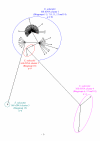The biochemical differentiation of Enterobacter sakazakii genotypes
- PMID: 17067387
- PMCID: PMC1634753
- DOI: 10.1186/1471-2180-6-94
The biochemical differentiation of Enterobacter sakazakii genotypes
Abstract
Background: Enterobacter sakazakii is an emergent pathogen that has been associated with neonatal infections through contaminated powdered infant milk formula. The species was defined by Farmer et al. (1980) who described 15 biogroups according to the biochemical characterization of 57 strains. This present study compares genotypes (DNA cluster groups based on partial 16S rDNA sequence analysis) with the biochemical traits for 189 E. sakazakii strains.
Results: Analysis of partial 16S rDNA sequences gave 4 well defined phylogenetic groups. Cluster group 1 was composed of the majority of strains (170/189) and included Biogroups 1-5, 7-9, 11, 13 and 14. Cluster 3 corresponded with Biogroup 15 and cluster 4 with Biogroups 6, 10 and 12. Cluster group 2 comprised a new Biogroup 16. For the isolates in this study, the four DNA cluster groups can be distinguished using the inositol, dulcitol and indole tests.
Conclusion: This study demonstrates an agreement between genotyping (partial 16S rDNA) and biotyping and describes a new biogroup of E. sakazakii.
Figures
References
-
- Iversen C, Forsythe SJ. Risk profile of Enterobacter sakazakii, an emergent pathogen associated with infant milk formula. Trends Food Sci Technol. 2003;14:443–454. doi: 10.1016/S0924-2244(03)00155-9. - DOI
-
- Simmons BP, Gelfand MS, Haas M, Metts L, Ferguson J. Enterobacter sakazakii infections in neonates associated with intrinsic contamination of a powdered infant formula. Inf Cont Hosp Epidemiol. 1989;10:398–401. - PubMed
-
- Farmer JJ, III, Asbury MA, Hickman FW, Brenner DJ, and the Enterobacteriaceae Study Group Enterobacter sakazakii: a new species of "Enterobacteriaceae" isolated from clinical specimens. Int J Syst Bacteriol. 1980;30:569–584.
Publication types
MeSH terms
Substances
LinkOut - more resources
Full Text Sources
Molecular Biology Databases


